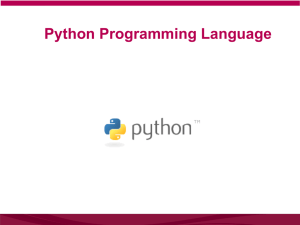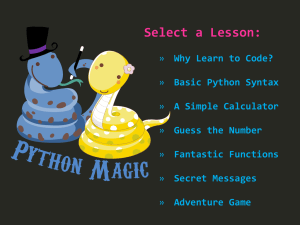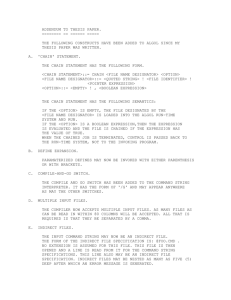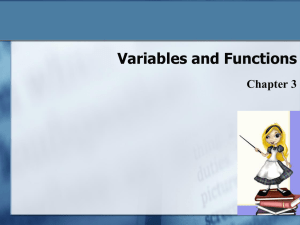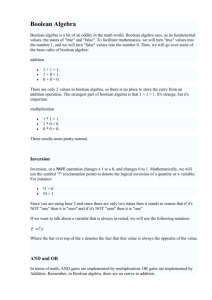1.3.3.A BranchingAndOutput
advertisement
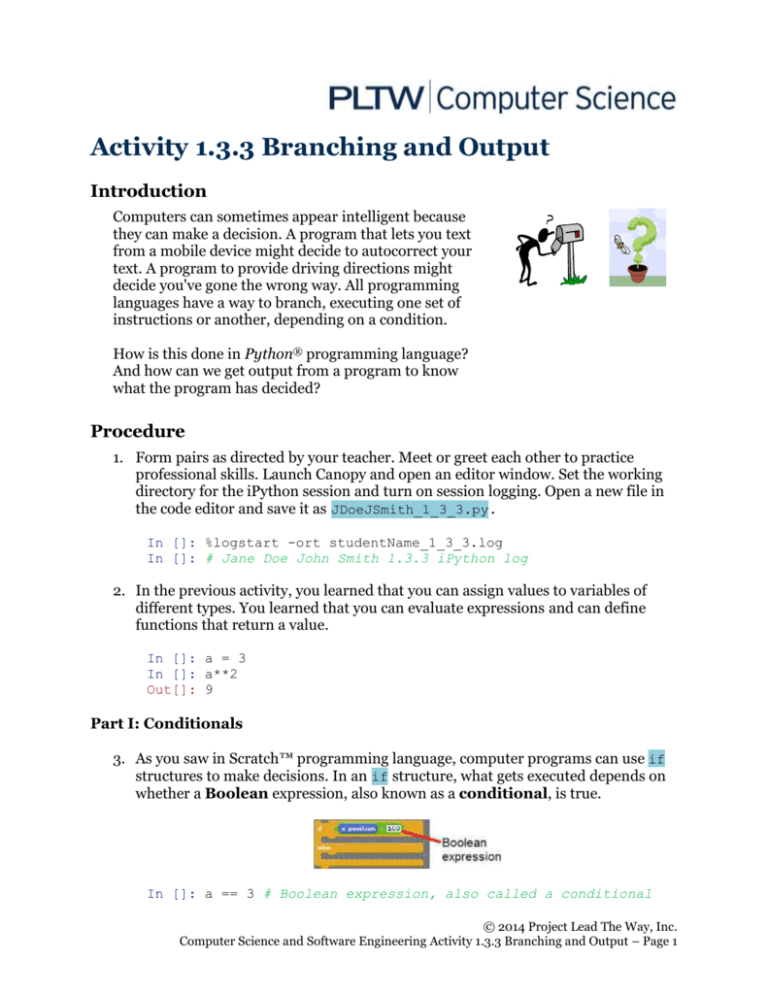
Activity 1.3.3 Branching and Output
Introduction
Computers can sometimes appear intelligent because
they can make a decision. A program that lets you text
from a mobile device might decide to autocorrect your
text. A program to provide driving directions might
decide you've gone the wrong way. All programming
languages have a way to branch, executing one set of
instructions or another, depending on a condition.
How is this done in Python® programming language?
And how can we get output from a program to know
what the program has decided?
Procedure
1. Form pairs as directed by your teacher. Meet or greet each other to practice
professional skills. Launch Canopy and open an editor window. Set the working
directory for the iPython session and turn on session logging. Open a new file in
the code editor and save it as JDoeJSmith_1_3_3.py.
In []: %logstart -ort studentName_1_3_3.log
In []: # Jane Doe John Smith 1.3.3 iPython log
2. In the previous activity, you learned that you can assign values to variables of
different types. You learned that you can evaluate expressions and can define
functions that return a value.
In []: a = 3
In []: a**2
Out[]: 9
Part I: Conditionals
3. As you saw in Scratch™ programming language, computer programs can use if
structures to make decisions. In an if structure, what gets executed depends on
whether a Boolean expression, also known as a conditional, is true.
In []: a == 3 # Boolean expression, also called a conditional
© 2014 Project Lead The Way, Inc.
Computer Science and Software Engineering Activity 1.3.3 Branching and Output – Page 1
Out[]: True
Note that the single = is used for assignment, while the double == is used for a
Boolean expression. Other Boolean operators include >= (for ≥) and != (for ≠).
You can make compound conditionals by connecting Boolean expressions
with and, or, and not. In the following examples, remember that a is still 3.
In []: a+1 >= 2 and a**2 != 5 # compound conditional
Out[]: True
The only two Boolean values are True and False.
Predict, try, discuss, and explain the output:
In []: # 3a. Prediction:
In []: a**2 >= 9 and not a>3
Out[]:
In []: # If prediction was wrong, discuss and explain
In []: # 3b. Prediction:
In []: a+2 == 5 or a-1 != 3
Out[]:
In []: # If prediction was wrong, discuss and explain
4. One situation where a programmer would use a compound conditional is when
deciding whether a mouse click is within a certain region on the screen. For
example, you might want your program to respond if a user clicks a rectangular
shape, like a button or tab, as shown in the figure on the left.
Creating a program that uses mouse input is part of Lesson 1.5. For now, we’ll
just assign x and y arbitrary values—let’s say (65,40), using the assignment
operator =. These coordinates are shown by the red dot in the figure above on
the right.
Unlike most languages, Python allows multiple assignment in a single line of
code, as shown here:
In []: x, y = (65, 40)
In []: x
Out[]: 65
© 2014 Project Lead The Way, Inc.
Computer Science and Software Engineering Activity 1.3.3 Branching and Output – Page 2
You might have noticed that the positive y-axis points down in the figure above.
Computer graphics usually number the pixel rows from 0 at the top left and
increase down and to the right across the screen.
The following expression is True when the red point (x, y) is in the blue area
shown above.
In []: 50<x and x<80 and 30<=y and y<=45
Out[]: True
Write a compound conditional to test whether (x, y) is in the rectangle shown in
the figures below. The conditional should be False since (x, y) is still bound to
the values (65,40) from before.
In []: # 4. Compound conditional
In []: (type your compound conditional here)
Out[]: False
5. Assign (90,115) to x and y to match the figure above with the mouse cursor on
the left and the red dot on the right. You can use the up arrow on your keyboard
to go back in the iPython session history and reuse the compound conditional you
typed in Step 4. You can press enter to execute the command again or modify it
before pressing enter.
In []: x, y = (90, 115)
In []: (arrow up to retrieve your compound conditional)
Out[]: True
Part II: if–else Structures and the print() Function
6. An if structure causes a program to execute a block of code only if a Boolean
expression is True.
Optionally, an else block can be included. The else block of code will be
executed only if the Boolean expression was False.
No matter whether the Boolean expression was True or False, the execution
continues after the else block of the if–else structure. The function below
illustrates the if–else structure.
© 2014 Project Lead The Way, Inc.
Computer Science and Software Engineering Activity 1.3.3 Branching and Output – Page 3
The function also shows the print() function, which will print its arguments on
the screen. The text inside the single quotation marks is called a string of
characters and will be printed as-is, without the quotes.
1
2
3
4
5
6
7
8
9
10
from __future__ import print_function # use Python 3.0 printing
def age_limit_output(age):
'''Step 6a if-else example'''
AGE_LIMIT = 13
# convention: use CAPS for constants
if age < AGE_LIMIT:
print(age, 'is below the age limit.')
else:
print(age, 'is old enough.')
print(' Minimum age is ', AGE_LIMIT)
The colons at the end of lines 3, 6, and 8 are required by def, if, and else key
words. The indentation tells the Python interpreter which block of code
belongs to that def, if, or else block. Just as Scratch grouped the code in
if/else blocks, Python uses indentation to group code. Always use four spaces for
each level of indentation. All such stylistic conventions can be found at
http://www.python.org/dev/peps/pep-0008/#indentation
When you try the code, notice that the output doesn’t come after an Out[]:.
This is because print() sends output to the system out, which by default is set
to be the screen. The print() command returns a null value, however. The
return value of a function or expression is what iPython displays (also on the
screen) after the Out[].
a. Copy the code above to the code editor. Execute the code, and then try the
following input. Discuss the output.
In []: age_limit_output(10)
In []: age_limit_output(16)
b. Define a new function report_grade(percent) that reports mastery if the
argument percent is 80 or more. You can write the function as an additional
function in the same file of code as before. The beginning of the new code is
shown here, and the required output is shown below. Pair program,
strategizing first.
12
def report_grade(percent):
© 2014 Project Lead The Way, Inc.
Computer Science and Software Engineering Activity 1.3.3 Branching and Output – Page 4
13
'''Step 6b if-else'''
In []: report_grade(79)
A grade of 79 does not indicate mastery.
Seek extra practice or help.
In []: report_grade(85)
A grade of 85 percent indicates mastery.
Keep up the good work!
Part III. The in operator and an introduction to collections
The in operator is another Boolean operator, like ==. Since it is Boolean, it returns
True or False. You can use it to see if an element is in an iterable. Iterables are
built out of zero or more elements and include strings as well as other variable types
like tuples and lists that are the subject of the next activity. A string is an iterable
that is made of elements that are characters.
Symbol Name
Quotation marks
Parentheses
Square brackets
Curly braces
Looks Like
'letters' or
"spaces"
( e1, e2, e3 )
[e1, e2, e3 ]
{key1:value1, key2:value2}
Iterable
string
tuple
list
dictionary
7. Examine the following examples using the in operator:
In []:'t' in 'string' # includes lowercase t character
Out[]: True
In []:'T' in 'string' # case matters
Out[]: False
In []: 3 in [1,2,3] # this list contains the int 3
Out[]: True
In []:'3' in [1,2,3] # '3' is a string, different than 3
Out[]: False
8. The following function vowel(letter) returns True if the letter is 'a',
'e', 'i', 'o', 'u', or any of their uppercase counterparts and returns False
otherwise.
1
2
3
4
5
6
7
def vowel(letter):
vowels = 'aeiouAEIOU'
if letter in vowels:
return True
else:
return False
# should check len(letter)==1
In your Python file for this activity, define a function
letter_in_word(guess, word) that returns True if guess is a letter in word
and returns False otherwise.
In []: letter_in_word('t', 'secret hangman phrase')
© 2014 Project Lead The Way, Inc.
Computer Science and Software Engineering Activity 1.3.3 Branching and Output – Page 5
Out[]: True
9. In MasterMind, one player has a secret sequence of colored pegs. Another player
tries to guess the sequence.
Define a function hint(color, secret) that takes two parameters: a string
(representing a color) and a list of strings (representing a sequence of colors).
The function should print a hint telling whether the color is in string.
In []: secret = ['red','red','yellow','yellow','black']
In []: hint('red', secret)
The color red IS in the secret sequence of colors.
In []: hint('green', secret)
The color green IS NOT in the secret sequence of colors.
Conclusion
1. Describe the relationship between blocks of code indented after the colon in if ,
elif, and else blocks.
2. There are many Boolean operators. List the ones you have learned about and
name one more that you learn about by searching for Boolean operators on the
Internet.
3. Steve and Latisha wrote this code:
21
22
23
24
25
if check == 2:
print('Code complete.')
else:
print('Code complete.')
print('Not all systems are ready')
Ira, Jayla, and Kendra are all saying it would be better to move lines 22 and 24 to
a single line executing print ('Code complete.') just before line 21. These
three students have different reasons for their opinions. Their reasons are below.
Do you think each of them is right, wrong, or somewhere in between? Explain.
Ira: “It would be better to have a single print statement because that code is going
to happen no matter what. The program will run slower by having it there twice.”
Jayla: “It would be better to have a single print statement because that code is
going to happen no matter what. Later, if you want to change your program,
you’re going to have to remember to change it in two places the way the code is
now.”
Kendra: “It would be better to have a single print statement because it is going to
happen no matter what. That program would take up less memory if you just
wrote it once.”
© 2014 Project Lead The Way, Inc.
Computer Science and Software Engineering Activity 1.3.3 Branching and Output – Page 6

